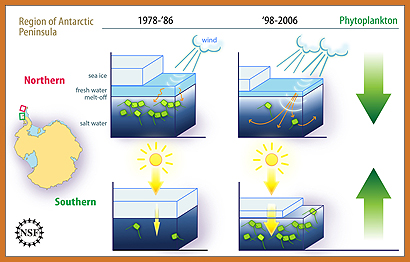Phytoplankton off the Antarctic Peninsula are responded to climate change in two ways. In the north, the amount of phytoplankton has shrunk because they are pushed to depths where they can not survive.In the south the amount of phytoplankton has increased. There, less sea ice cover lets more sunlight get through, allowing phytoplankton to grow.
Click on image for full size
Courtesy of Zina Deretsky / NSF
Warmer Temperatures are Changing Antarctic Phytoplankton
News story originally written on March 16, 2009
The Antarctic Peninsula is warming faster than most other places in the world. Warmer temperatures mean that there is now less sea ice in the nearby Southern Ocean. Plus winds are changing too.
Scientists have discovered that climate change is affecting some of the ocean’s tiniest creatures. These creatures, called phytoplankton, are changing as the area’s sea ice and winds change because of global warming. These single-celled creatures float in ocean water and, through photosynthesis, get their energy from the Sun.
The phytoplankton in the northern and southern areas of the Antarctic Peninsula is not changing in the same way because of global warming. That surprised the scientists.
In the north, there is less sea ice and more wind. This causes the seawater to mix more than it used to. The mixing causes less sunlight that gets through the water. With less sunlight, phytoplankton are doing less photosynthesis.
In the south, sea ice used to cover most of the seawater for most of the year. Now, there is less sea ice. This exposes seawater to sunlight. There is also less wind in the south, so less seawater is mixed than in the north. More sunlight gets through the water. More sunlight leads to more photosynthesis and more phytoplankton.
Last modified May 1, 2009 by Lisa Gardiner.
You might also be interested in:
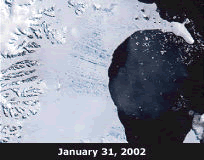
Antarctica is a cold place. If you were to go visit, you would need a thick winter coat, hat, and mittens. However, along the coast, in an area called the Antarctic Peninsula, it has been getting
...more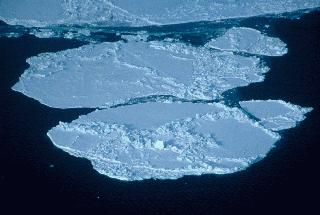
Sea ice is frozen seawater. It floats on the oceans that are in Earth's polar regions. The salt in the seawater does not freeze. Very salty water gets trapped in the sea ice when it forms. The pockets
...more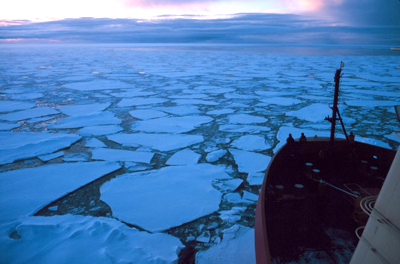
The Southern Ocean is sometimes known as the Antarctic Ocean or South Polar Ocean. It surrounds Antarctica in the South Polar Region. The Southern Ocean is a bit different from other oceans. Other oceans
...more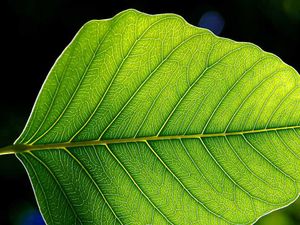
There are many different kinds of plants. Some have big leaves. Some have small leaves. Some even have flowers. All plants make their own food. When sunlight hits the leaves of a plant, photosynthesis
...more
Earth’s climate is getting warmer. During the past 100 years Earth’s average temperature rose about 0.6° Celsius (1.0° F). Things that people are doing like burning fossil fuels, changing the way land
...more
Wind is moving air. Warm air rises, and cool air comes in to take its place. This movement creates the winds around the globe. Winds move at different speeds and have different names based on their speed.
...more
Antarctica is the coldest, windiest, and driest continent on Earth. It is about one and a half times the size of the United States. Almost all of Antarctica is covered with a thick layer of ice called
...more


